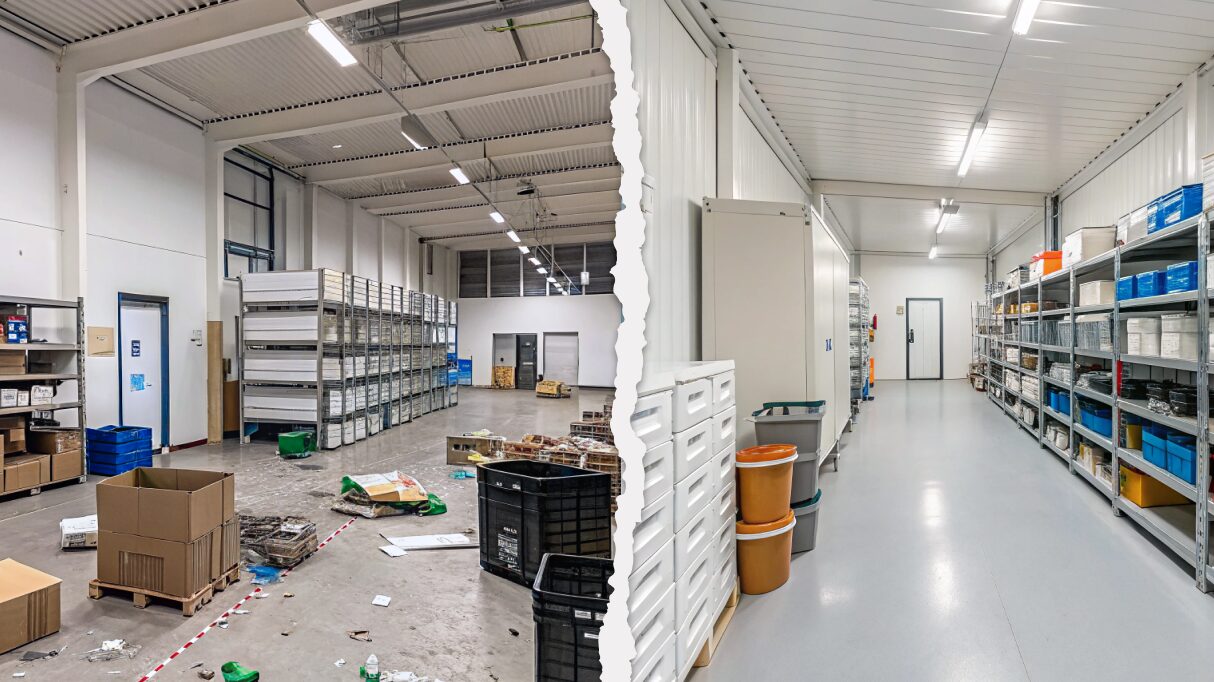Mismanaged inventory contributes to a staggering $1.1 trillion in losses globally each year, and that’s just the start. For contractors, the stakes are equally high. Inaccurate and inefficient material management can lead to significant financial setbacks, including lost revenue and increased operational costs.
With rising material costs and supply chain challenges, keeping tight control over your inventory isn’t just smart, it’s essential. And while it might not be the flashiest part of your job, it’s one of the most important.
The good news? A few smart strategies can bring you more control, clarity, and serious savings.
Tip #1: Label Everything
While many businesses stay classic when labelling, it can be difficult to maintain what’s done with pen and paper. Humidity, heat, and warehouse dust can cause paper labels to peel, smudge, or disappear altogether, causing an inconvenient, yet avoidable issue.
So what are some hassle-free alternatives?
- Barcodes are a great fit for parts bins, stockroom shelving, and anything that gets inventoried frequently. They’re fast to scan and reduce human error.
- NFC tags work well for high-value tools or equipment that moves between trucks, sites, or techs. They can store more data and are scanned with a phone.
- Color-coded or magnetic labels help techs identify items at a glance, especially in fast-paced environments or mobile trucks.
- Heat-shrink labels are an ideal option for wires, tubing, or smaller parts. Apply heat and the label shrinks to a perfect fit, without peeling or rubbing off.
- RFID tags are ideal for fast audits and bulk scanning in warehouses. Though they require an RFID reader, they can be read from several feet away without needing a direct line of sight.
Tip #2: Use Requests for Quotes (RFQs) and Purchase Orders (POs) Wisely
When it comes to ordering materials, there’s more than one way to get the job done. RFQs and POs might seem like just more paperwork, but they’re critical for avoiding miscommunication and keeping track of materials. Without clear processes, it’s easy to lose track of what you ordered, what’s en route, and what never arrived.
- RFQs are your best bet when you’re comparing options. They let you shop across multiple suppliers, request pricing, and check availability before committing to an order. It’s ideal when you’re sourcing new materials or trying to get the best deal.
- POs come into play when you already know who you’re buying from. They help track what you’ve ordered, when it’s coming, and who received it, keeping everything organized and accounted for.
One example? The team at Kyle Plumbing found themselves digging through old POs to see if unused parts could be returned. Without a clean record of what came in and where it ended up, too many materials sat unused. Once they tightened up their PO process, they gained full visibility, from approval to delivery to return.
Here are a few ways to do the same:
- Use RFQs when you want to compare vendors or pricing before placing an order.
- Log who created and approved each PO to boost accountability.
- Include expected delivery dates so you can stay ahead of delays.
- Track delivery at the point of receipt, whether at the warehouse or during a truck restock, to catch issues early.
Tip #3: Separate Warehouse vs. Truck Systems
Even though you’re working with the same materials, warehouses and trucks serve different functions, so your inventory strategy should reflect that. Treating them the same way only leads to double-counting, stockouts, and confusion in the field.
- Warehouse inventory should be your central hub. It’s where you manage bulk stock, receive vendor deliveries, and plan replenishment.
- Truck inventory is your jobsite-ready kit. It should be lean, organized, and easy for techs to restock quickly.
Keeping these systems separate, yet connected, provides better visibility into what’s on hand, what’s been used, and what needs replenishing. This can reduce waste, speed up jobs, and keep your team focused on the work, not the hunt.
Tip #4: Cycle Count Regularly
Unfortunately, inventory management isn’t a one-and-done process. Without regular audits, it’s easy for small discrepancies to snowball into serious losses. That box of copper fittings that “should be there”? Turns out it was used last month and never restocked.
So how can you run a successful cycle count?
It all starts by setting up a cadence that fits your business, be it monthly, quarterly, or before busy season. But again, it doesn’t just stop at that. Making it part of your routine, even spot-checks on high-use items, can go a long way.
Incorporating tools like barcode scanning or mobile audits, can be a big help too. They reduce manual errors and help your team stay consistent across locations and techs.
Tip #5: Train Your Team
Inventory management processes are only as strong as the people running them. If techs don’t understand how to check items in, log usage, or flag low stock, managers and teams will always be playing catch-up.
But training doesn’t have to be formal or time-consuming. A quick onboarding session, simple how-to videos, or even laminated cheat sheets in the warehouse can make a big difference.
Just as crucial is explaining the why of it all. When techs understand that better inventory means fewer delays, faster jobs, and less hassle on-site, they’re much more likely to stay consistent.
Tip#6: Leverage Technology
This one might seem obvious, but many businesses still manage inventory the way it’s always been done: by memory, spreadsheets, or handwritten notes. And while that may work for some parts of the job, it leaves too much room for error when it comes to tracking parts and materials.
The good news? There are tools built specifically for field service teams that can help ditch the guesswork. Inventory platforms can replace pen and paper, reduce manual entry, and give real-time visibility into your stock levels, whether in the warehouse or out on a truck.
Implementing tech doesn’t mean overhauling your entire operation overnight. But even small steps, like using a mobile scanner or switching to digital POs, can save time, reduce waste, and help teams focus more on the job and less on what’s missing.
Closing
Inventory management might not seem like it, but it has a huge impact on your day-to-day operations, as well as your bottom line. From better labeling to smarter POs and tech adoption, small changes can create big improvements.
Start with one or two tips that make sense for your business, and build from there. Because when your inventory works for you, your whole team can move faster, waste less, and get more done.
Want to see how Ply helps field service teams take control of their inventory? Let’s talk.



